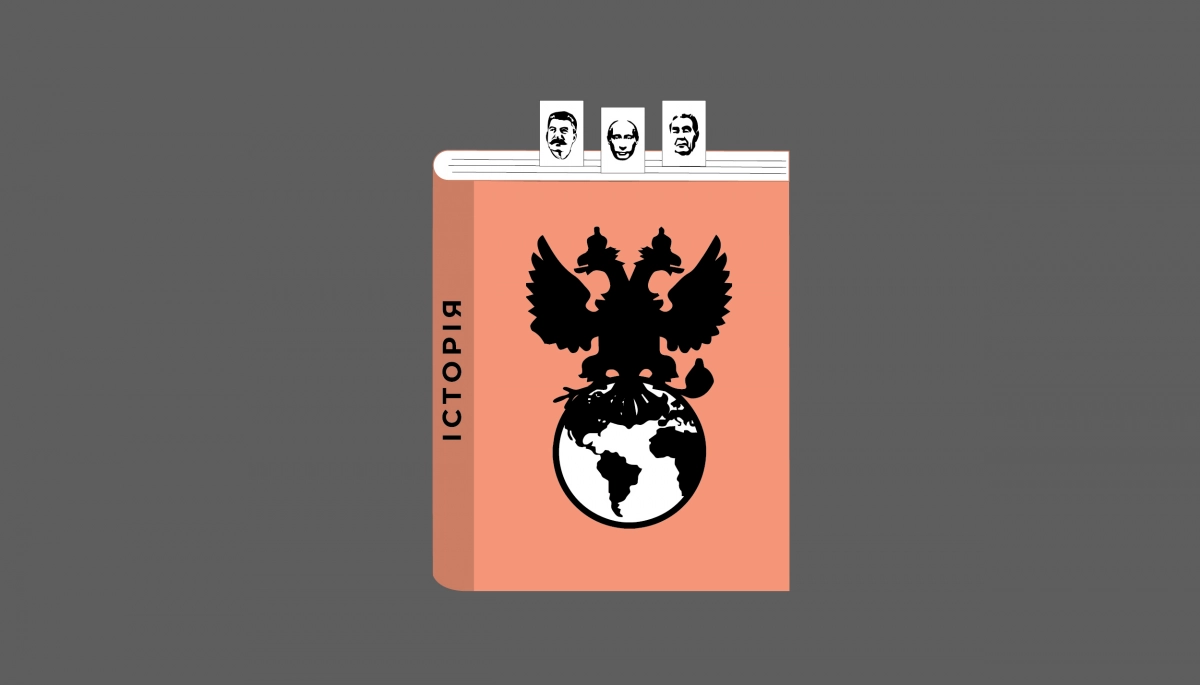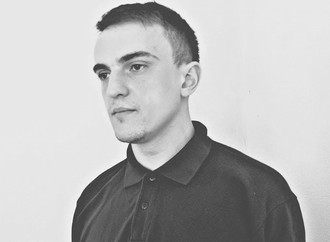Українською читайте тут.
November 7 is approaching — the former "red date" on the calendars and a central calendar event of Soviet historical mythology. On this day, Soviet schoolchildren were taken out for demonstrations. During school classes, they were taught about the "good grandfather" Lenin and the "Great October Socialist Revolution", which "showed a bright path for progressive humanity." History was taught as the main ideological subject in schools strictly according to the Communist Party’s methodology; the pages of textbooks were full of quotes from general secretaries and decisions of congresses of the CPSU (Communist Party of the Soviet Union). Soviet Ukraine’s educational institutions had a subject called "history of the Ukrainian SSR", although very few hours were allocated to teaching it.
November 7 has not been celebrated for a long time, not only in Ukraine but even Russia. The successor of the USSR, Russia, built its historical myth. The Soviet Union is present there as one of the forms of existence of the "Great Russia" — in between the Russian Empire and Putin's regime. At the same time, Soviet practices are returning to Russian schools: for the first time since 1991, a single unified textbook has been introduced. Its pages contain quotes from Vladimir Putin and discuss how the new "good grandfather" saved world civilization from destruction. Instead of the November demonstrations, Russian schoolchildren, according to Radio Liberty, now begin each school week by raising the flag and singing the national anthem. The Kremlin’s policy regarding the "special military operation" is also explained to children during the mandatory "Conversations about important things" class hours. DM will explore how Russian agitational propaganda instrumentalizes the past, rewrites history textbooks for high school students, and distorts the events after 1945.
The latest edition of the new History of Russia and world history textbooks for 10-11th high school grades was written by the Russian politician Vladimir Medinskiy, "a man of Putin’s ideological clan", the Minister of Culture of Russia in 2012-2020, and now an assistant to the President of Russia. As a minister, Medinskiy was remembered, in particular, for stating that the Russian people have one extra chromosome. Medinskiy's scientific dissertation to become a doctor of historical sciences was at one time criticized by the scientific community for plagiarism, unscientific nature, ideologization, and a lot of errors. However, it did not prevent Medinskiy from writing "historical" articles, which were published under Putin’s name, in particular, the opus "On the historical unity of Russians and Ukrainians". The co-author of the textbooks was the rector of the Moscow State Institute of International Relations, Professor Anatoliy Torkunov, who is under Ukraine and Canada’s sanctions for "creating and spreading misinformation financed by the Kremlin."
- Read also: The world is a secret service, and the people are its agents: Russian propaganda’s view on domestic and international politics
Since September 1, 2023, Medinskiy and Torkunov’s textbooks will also be used by Ukrainian children in the Ukrainian territories occupied by Russia. In contrast to Soviet times, the subject of the history of Ukraine is wholly excluded from the school curriculum. DM has analyzed the textbook on the history of Russia for the 11th grade to find out which propaganda messages are being planted in the minds of Ukrainian teenagers.
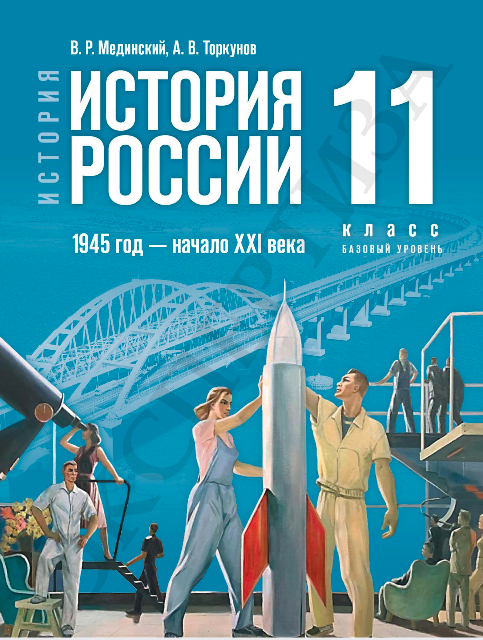
Loser-Reformers and Conservative Leaders: From Stalin to Putin
The new textbook took a big step forward in the "rehabilitation" of Joseph Stalin in Russian public discourse. However, the authors avoid giving the "leader of nations" their positive assessment; they encourage students to make this decision by themselves, telling how contemporaries supposedly treated Stalin. The death of the "long-time leader of the state" allegedly caused the USSR’s population "confusion, fear, and sincere grief." It is an attempt to revive the personality cult debunked in 1956 to justify the repressive practices of one of the bloodiest periods of Soviet history. DM analyzed the "personality cult" tactics here.
The textbook says that all over the world, "ordinary people" remembered Stalin's role in the victory over the Nazis and seemed to feel regret even though "many pro-American newspapers and magazines called the late leader a tyrant and dictator." Thus, for the first time, the textbook discussed the topic of "malicious" Western media, which tries to discredit Russia in the world and destroy it from within. In the future, this rhetoric will be repeated more than once, and DM will be discussed separately.
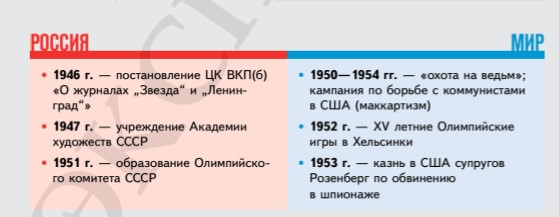
At the beginning of each chapter, the authors put a synchronous table that lists the main events in Russia and the world. These tables should demonstrate to students that Russia defends itself from the West and that "not everything is so clear-cut." The chapter on late Stalinism shows a table that devalues the significance of Stalin's repressions. In the USSR column', only the resolution of the Central Committee of the CPSU(b) "About the magazines "Zirka" and "Leningrad"" is mentioned as a repressive episode (a party decision, after which another attack on culture began). But the column of world events includes the American "witch hunt" (McCarthyism) and the execution of the Rosenbergs for espionage. One should compare: on the one hand, in the USSR, a party resolution is simply issued; on the other hand, in the USA, a whole repressive campaign is launched, and people are executed. A student would think, "So where were the real repressions happening?".
This chapter’s text discussed a little more about the late Stalinist repressions with a noticeable tendency to downplay it and silence Stalin’s role. However, interpreting the repressions against the Crimean Tatars deserves special attention. They were deported to Central Asia as a people "accused of helping the occupiers" — and not a word is said that these accusations were fabricated. However, there is a fake about Soviet authorities’ further "care" for the deported people. According to it, Central Asia’s local authorities "made every effort to improve Crimean Tatars' food and lifestyle." The student most probably should get the impression that the Soviet authorities treated the Crimean Tatars with even condescension: they "collaborated with the Nazis", for which they were resettled, but they were helped in every possible way to settle in a new place. It is worth noting that the textbooks for the 10th-grade mention of Chechen people as "collaborationist" led to a scandal: Kadyrov ordered to remove all copies of the textbook from the republic's schools, the Chechen authorities demanded an apology from Medinskiy, and Putin's assistant promised to rewrite the chapter. Crimean Tatars do not have such a powerful political lobby in Russia, so they remain described by the dubious status of "guides of the Nazi occupiers" in the textbook.
According to the textbook, Stalin's next crime against Ukrainians, the Holodomor of 1946-1947, was turned into a famine caused by "drought and crop failure" in "several country’s western regions". Russian historians deny the fact of three Holodomors in Ukraine, so the textbook did not even mention the Ukrainian SSR.
A considerable section on the Korean War ends with a telling conclusion: "Two superpowers possessing atomic weapons, at the height of the confrontation, managed to reach a compromise that stopped the active phase of the confrontation on the Korean Peninsula." The textbook’s reader is led to think about the wisdom of superpower leaders’ decisions at that time, in contrast to modern Western leaders, who are not inclined to the "Korean option" of ending the war in Ukraine, which the Kremlin seeks.
The textbook’s authors admit that after the death of Stalin, the USSR felt the need for reforms. According to it, the Stalinist model was influential during the war and post-war reconstruction, but it was time to "loosen up" a little. Nikita Khrushchev is presented as a controversial historical figure in the textbook. His foreign policy is quite highly rated: first, he offered reconciliation and rapprochement to the West, and when the USA went on the offensive again, he gave a decent response in the form of a hydrogen bomb, the Berlin Wall, and missiles in Cuba. Parallels can be drawn with the propagandist representation of Putin's foreign policy. Initially, Putin allegedly offered the West to make peace (in the form of a meeting with Biden and a request to NATO in 2021), and when the West did not want "peace", he started a "special military operation".
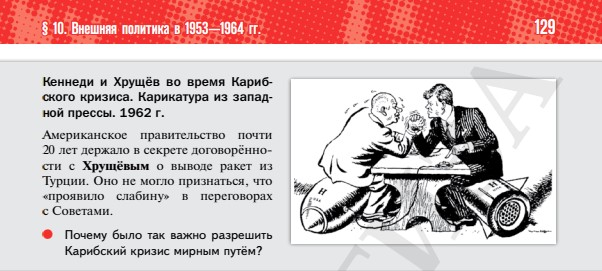
However, in domestic politics, according to propagandists, Khrushchev failed. His actions were allegedly "chaotic and thoughtless", and his "noisy political campaigns" eventually tired the USSR’s population. Medinskiy and Torkunov paid the most attention to Crimea’s transfer to the Ukrainian SSR in 1954. In their interpretation, first, it was only Khrushchev's "personal initiative" and his other "ill-considered decision". Second, this decision did not observe the "norms of Soviet legislation". Third, no one asked "the opinions of Crimeans". Fourth, within the framework of a unified state, this decision may not have been a fundamental issue. Still, the collapse of the USSR fundamentally changed the situation, so in 2014, Russia "restored historical justice." The textbook runs a red thread through the thesis that border changes during the Soviet era, and especially the collapse of the USSR, happened contrary to the former legislation. In light of this, the violation of treaties and international legislation by Putin's Russia should not look so blatant. For example, too many officials voluntarily changed the borders, violating the laws. However, most importantly, authorities need to ask the opinion of the local population (i.e., hold a "referendum").
The image of Leonid Brezhnev, according to propagandists, is unequivocally positive. He is friendly, benevolent, and wise at the same time. He understands psychology and knows how to select personnel. "Brezhnev considered his main tasks the preservation of peace and ensuring the growth of the welfare of the Soviet people", the textbook says. The authors did not skimp on quotes from contemporaries and historians who "praise" the leader. Even in his old age, Brezhnev had health and diction issues. Still, he was advantageously different from other Soviet leaders: he was not inhumane like Lenin, cruel like Stalin, or hysterical like Khrushchev. The textbook’s authors glorify gerontocracy in particular because Putin is entering the age of the late Brezhnev (Putin is now 71, Brezhnev died at 75), but, of course, not only because of this. Brezhnev brought the state back to a conservative course of development. Similarly, Brezhnev started large-scale national projects and interventions in neighboring countries. Again, Brezhnev, unlike Stalin, did not carry out large-scale repressions but "effectively" suppressed the opposition. The dissidents' image in the textbook is similar to the opposition’s image in the pro-Putin media. Dissidents were closely "guarded" by the West, and, therefore, their activities were monitored by the state security agencies. It was also important considering the terrorism threats.
Mikhail Gorbachev is represented the most negatively of the Soviet leaders. According to the agitational propaganda, he started "incoherent and ill-conceived reforms" that did more harm than the lack of reforms under the late Brezhnev. Since 1989, Perestroika acquired an "increasingly destructive character". According to the textbook’s authors, Gorbachev was a vain man, and the "insidious West," with the help of flattering reviews, publications in the press, and the Nobel Peace Prize, pushed the Soviet reformer to greater and greater concessions in foreign policy. Therefore, Gorbachev "ruined" Russia’s geopolitical stakes, which Stalin achieved in the Second World War.
The textbook’s reader can trace the contrast between the figures of conservative Soviet leaders (Stalin and Brezhnev), under whom the USSR achieved foreign policy victories and a high level of welfare, and "reformer" leaders (Khrushchev and Gorbachev), who implemented rash reforms and put all these achievements at risk. Similarly, in the history of Russia, the textbook contrasts the failed reforms of the 1990s under Yeltsin with economic growth, social harmony, and "restoration of historical justice" on the world stage in the era of Putin. Thus, the historical narrative is used to justify and glorify Putin's conservative authoritarianism.
Western media as an "enemy weapon"
The textbook depicts the "Collective West", led by the USA, as an inherent enemy of Russia. It is aggressive and insidious at the same time. Moreover, it aggressively promotes its interests under the democracy slogans. The West allegedly unleashed the Cold War, during which it only ostensibly accepted the USSR’s peace initiatives and continued to pursue the destruction of the Soviet Union. Western special services oversaw the post-war anti-Soviet armed underground forces, later dissidents, national movements, and the anti-Soviet opposition in general. The West could not defeat the USSR in a direct armed conflict; parallels are drawn with the First World War, which Russia, they say, did not lose in the military sense but was destroyed from within by subversive forces supported from abroad.
The textbook says that during Perestroika, the West saw "a historic chance to eliminate its main geopolitical competitor from the international scene." For example, by recklessly introducing the policy of "glasnost", Gorbachev allowed the West to unleash an information war, during which "an avalanche of destructive and hostile information fell on the citizens of the USSR", and Soviet official propaganda responded clumsily. Soviet citizens despaired of the possibility of preserving a single country and could not oppose the process of the disintegration of the Union. Students are led to the need to protect "sovereignty in the information space". Therefore, only by censoring the information space can the state stand up against geopolitical enemies.

Russia had accepted the statements of the West about the end of the Cold War "seriously and with confidence". When the West "collapsed" the USSR, after which the Russians allegedly became "the largest divided nation in the world", it did not calm down. Today, allegedly, its goal became the dismemberment of Russia, similar to the "Yugoslavian scenario". In the 1990s, Western propaganda "attacked" Russian society. Instead of "traditional" Russian values (modestly listed: goodness, justice, collectivism, mercy, sacrifice), the West seemingly imposed individualism, materialism, and contempt for other people's suffering. Western media allegedly launched a "broad campaign" in support of Chechen separatism. The West has established a "circle" of post-socialist and post-Soviet states around Russia, where it promoted nationalist Russophobes to power. Only after Putin came to power was separatism defeated — Russian society consolidated again and returned to the traditional development path.
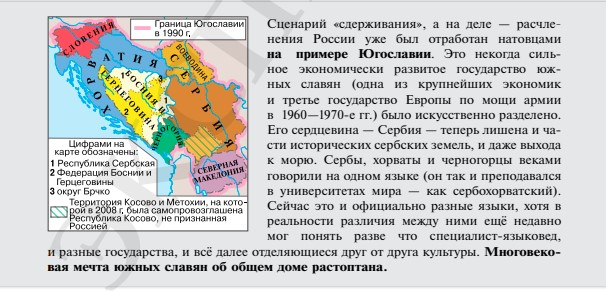
Accordingly, the West seemed frustrated witnessing Russia's return to its geopolitical positions. In 2008, Russia was "forced to respond to Georgia’s aggressive steps" (i.e., Russia attacked a neighboring country), and the Western mass media launched a full-scale campaign to expose Russia as the aggressor. But this finally dispelled the "myth" about their objectivity. The current crisis in international relations is, of course, caused by the actions of the United States and its allies. At the beginning of the chapter "Russia today. Special Military Operation (SMO)", the textbook provides a synchronous table. The "Russia" column mentions the "reunification" of Crimea, the SMO beginning, and the "incorporation" of new regions into Russia. In contrast, the "World" column is packed with dates of aggressive actions by Western powers: the invasion of the US and its allies in Syria (2014), NATO's intervention in the civil war in Libya (2015), the end of France's invasion of the CAR (2016). In addition, the authors provide a fake narrative about the USA and ISIS cooperation aimed at overthrowing Bashar al-Assad’s "legitimate government".
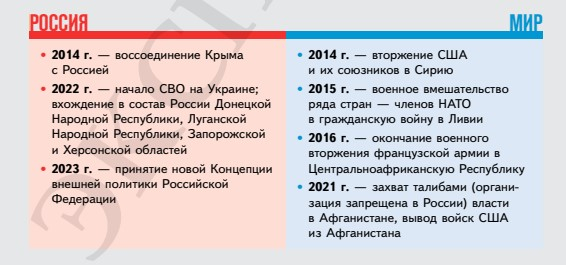
The West has directed its powerful weapon, the media, to discredit the SMO. A whole "global industry" has been created, which continuously manufactures staged videos, fake photos, and videos, and Western social networks and mass media supposedly enthusiastically spread them around the world. At the same time, Russia is "groundlessly" accused of conducting "sophisticated television propaganda."
The textbook recommends students be vigilant, think about why famous bloggers spread certain news, and urge them not to become "victims of cheap manipulation". In this way, the Russian authorities are trying to "disconnect" children in the occupied territories from the Ukrainian information space, portraying the pro-Western media space as a repository of fakes and manipulations that should not be trusted. Russian propagandists resort to mirroring tactics: Western media is represented by propaganda, and Russian media is represented by counter-propaganda, which exposes the tools of the information war unleashed by the West against its geopolitical enemy. Ironically, Medinskiy and Torkunov accuse the US and the EU of developing "textbooks" that falsify history, portraying Russia as an aggressor and colonizer.
Ukraine in a crooked mirror: from the "Austrian General Staff" to the "junta"
Putin's article "On the Historical Unity of Russians and Ukrainians" in 2021 marked the departure of Russian propaganda from the Soviet narrative about fraternal (very close, but still separate) peoples and a return to the Russian Empire’s narrative about a "triune nation" consisting of "Great Russians", "Little Russians", and Belarusians. It is not surprising that the new Russian textbook says so much (and sometimes, on the contrary, not a lot) about the history of Ukraine.
In the Special Military Operation chapter, the authors go beyond the chronological boundaries of the 11th-grade program to provide students with historical fakes and manipulations circulated in Russian public discourse and even historical science for many years but have not yet entered the pages of school textbooks. The etymology of the word "Ukraine" is being manipulated, undermining the idea of it as an independent state —according to the propaganda version, it simply is "the outskirts of Russia." In the 17th century, the Cossacks "became" part of the Russian state, allegedly as part of the Russian people. In the 19th century, the Ukrainian national movement was a "project of the Austrian General Staff" aimed at keeping the Slavs who gravitated to Moscow in the Habsburg Empire. The population of Western Ukraine at that time was supposedly Russian-speaking. Still, it was the first time that the "technologies" of creating an "anti-Moscow Russia" were tested on it. The Austrian authorities introduced an "artificial language" and national symbols, and the professor of Lviv University, Mykhailo Hrushevskyi, became the "evil genius" who invented the history of Ukraine. Technologies were applied to the Galician "Russians" for so long that they allegedly believed in them themselves and turned into malignant Western Ukrainians, who in the 20th and 21st centuries will have a negative impact on the "Easterners" by imposing "Ukrainianism" on them. Ukrainian "separatism" "created by Austria" was adopted by Germany in both of the two world wars — with this thesis, Ukrainian nationalism is directly equated with (neo)Nazism.
The chapters on Soviet history avoid mentioning the contribution of Ukrainians to the victory over Nazism, the participation of the Ukrainian SSR in the creation of the United Nations, and the economic importance of the second-largest industry in the Soviet Republic. Students should not get the impression that Soviet Ukraine played a prominent role in the Union because it corresponds to the narrative of "fraternal nations" but by no means about "one nation". Instead, the textbook discusses the history of Ukrainian nationalists who were supported by Western special services after the defeat of the Reich. The textbook describes the UPA members as collaborators who terrorized the civilian population. To further demonize the image of Bandera’s supporters and followers, the propagandists also mention the UPA in the paragraph about the increase in crime after the Second World War. The UPA has been compared to a "criminal group that engaged in murders and robberies." The Soviet authorities crushed Bandera’s supporters and sent them to camps. Ukrainian nationalism allegedly disappeared for a while. But, the impulsive Khrushchev made a mistake and "rehabilitated" the collaborationists in 1955. To build a logical transition from Bandera’s supporters to the Ukrainian independence movement, nationalists constructed an interesting fake. It turns out that the former collaborators returned home to "Western Ukraine", where they actively engaged in social work and built careers, once again spreading the germs of separatism.
The textbook reproduces Soviet ideological stereotypes: allegedly, joint efforts during the Second World War started the process of forming a Soviet nation. In the Soviet Union, this formation was officially recreated only in the Brezhnev Constitution of 1977. Propagandists lead readers to the conclusion that the Soviet people are a potential base for increasing the population of Russian people. Medinskiy and Torkunov emphasize that at the end of the 1970s, in most Soviet republics, every fifth wedding was international, and "children in mixed marriages were Russians." It also recognized (and approved) assimilation, as well as the feeling of cultural superiority of Russians over neighboring peoples, which is generally inherent in Russian propaganda but is denied by it in every way. The authors praise the Soviet national policy: "unique in the history of world civilization, the reduction of the level of inter-ethnic conflict", "such unity has no analogs in the entire previous history of our country", and "accumulated experience of cultural mutual understanding". It is only unclear why, in the conditions of such an idyll, in a dozen years, the majority of the population of the Ukrainian SSR will follow the lead of "Western propaganda", "expanders from the Western regions", and "self-interested republican elite", voting for independence.
The Russian historical narrative, like any propaganda, is woven from mutually contradictory paragraphs. For four decades, the "united Soviet people" rhetoric was successfully promoted (with the prospect of turning Ukrainians into Russians). Still, after not silencing "enemy voices" (e.g., allowing freedom of speech to Western mass media) for four years —the Soviet Union collapsed.
Regarding post-Soviet history, it is emphasized that Russia took over the debts of the USSR, leaving all assets to the new states and thus providing them with a "good start". It is noted that strong economic ties have remained between Ukraine and Russia, and the Ukrainian economy could not fully develop without Russian energy resources. Because of this, it seemed that both states should "strive for greater integration". Yet, it did not happen because "mutually beneficial cooperation and good neighborliness between Russia and Ukraine contradicted the long-term interests of the West to "contain" our country". While discussing Ukraine at the end of the 20th century, Medynskiy and Torkunov resort to anachronism. Ukrainian nationalist and anti-Russian politicians in the 1990s were already allegedly in power; the volume of Ukrainian-Russian trade was decreasing; Kyiv was taking a course toward the West and distancing itself from Moscow, receiving loans from the IMF under the conditions of market reforms, Western non-governmental organizations were widely active (of course, primarily with the help of Soros's demonic fund). The historical policy of Ukraine consists of "silencing" the "Soviet heroes’ feats" and the glorification of the OUN-UPA. The distorted elements of "the creation of anti-Russia" are borrowed from the history of Ukraine in the later period — already after the Orange Revolution and even after 2014.
Why did Russian propagandists need such a shift in chronology? The history of independent Ukraine fits better with the narrative of the hostile West, which, after the collapse of the USSR, immediately switched to creating extra issues for Russia. It should also justify the aggressive actions of the Russian authorities against Ukraine, which began long before 2014, such as a series of "gas wars" starting in 1992, the decision of the Verkhovna Rada of Russia on the status of Sevastopol as a "Russian city" in 1993, the conflict around the island of Tuzla in 2003... If a student from the occupied territories receives information about these events from other sources, they will conclude that these were the Kremlin’s justified actions against the "Russophobic" country. After all, the "ultra-nationalist regime" in Ukraine, which will be discussed further, could not arise out of nowhere but had to be formed over decades. "Several generations in Ukraine, starting from the 1990s, were brought up on neo-Nazi ideas in hostility to Russia."
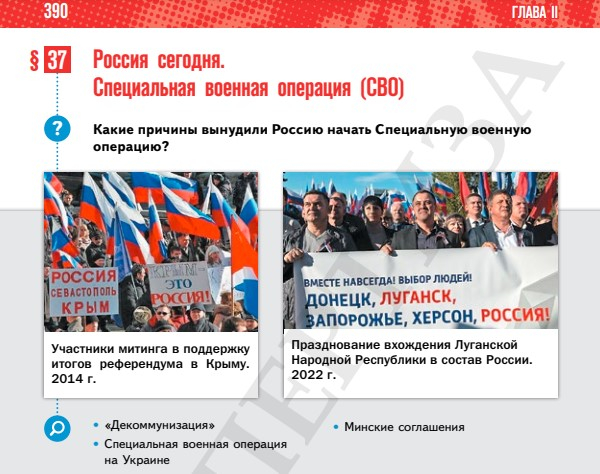
Because of the idea that Ukraine has been a nationalist state since the 1990s, the textbook avoids mentioning the pro-Russian presidency of Viktor Yanukovych — it only says that he was ousted in 2014 by an "armed mutiny" that brought a "junta" to power. The textbook "cements" in the minds of students the flow of propaganda that they already receive from the Russian mass media and social networks.
The textbook's chapter on "Russia today. Special Military Operation (SMO)" is filled with fakes and disinformation created by Russian agitational propaganda after the Revolution of Dignity. According to it, the new Ukrainian government immediately established an "ultranationalist regime under the dictates of the West and the Western Ukrainian minority", which began to ban everything in Russian and oppress the Russian-speaking population (according to the textbook’s authors, 80% of the population of Ukraine). Meanwhile, the Ukrainian language, taught in the Soviet Union, was replaced by the Western Ukrainian "dialect".
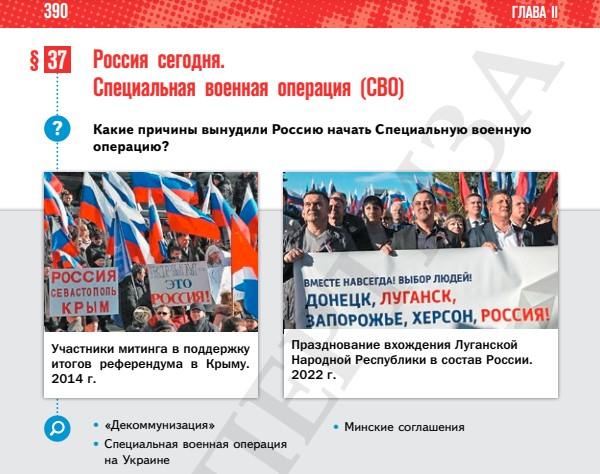
The annexation of Crimea was caused by "Ukrainian authorities’ threats to expel the Russian Black Sea Fleet from Sevastopol." "Nazis" from volunteer battalions suppressed pro-Russian demonstrations in Kharkiv and southern Ukraine, "burning alive" dozens of protesters in the Odesa Trade Union Building. Donbas witnessed a "people's uprising" and a militia formed from "Afghan veterans, policemen, teachers, and miners". Volunteers from Crimea and Russia joined them, and the Russian military allegedly took time off and, on their initiative, went to the east of Ukraine to fight, just as the tsarist officers of Alexander II's time went to help the Bulgarians who rebelled against the Ottoman Empire. After signing the Minsk agreements, the Ukrainian authorities were, in fact, in a "secret conspiracy with NATO" and simply "fooled" the participants of the negotiation process. The leaders of Germany, France, and Ukraine later admitted that they had no intention of holding Minsk-2. The "updated Kyiv regime" (i.e., the government of President Zelenskyy) in the textbook’s prism looks even more Nazi, the enemy of all progressive humanity. After all, in the early 2020s, Ukraine opened "American bio laboratories" on its territory, was going to restore nuclear weapons and join NATO, and then attack Crimea and Donbas, provoking the "end of civilization", which Putin prevented by starting his SMO. So, the president of Russia was saving not only the existence of the Russian people (which is what Putin's quote is about) but also the existence of all humanity.
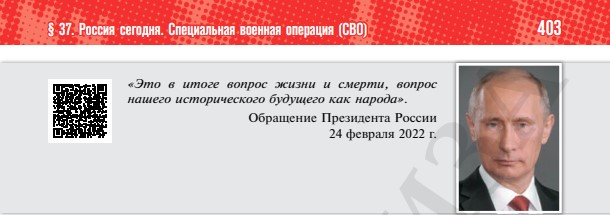
Russia "takes care" of the annexed "new regions" by building residential buildings, roads, schools, and hospitals. Western sanctions have only "benefited" Russia: the state and business are replacing imports with national production, the economy is growing, and new prestigious jobs are becoming available that students can occupy after completing their education. Instead of the Ukrainian "death of civilization", children from the occupied territories now await the Russian "new times" with excellent prospects. "It is this time that gives you, school graduates, a huge chance to achieve quick, professional success in adult life, in business, in production, in science. Such unique times do not happen often in history. After the departure of foreign companies, many markets are open to you. There are fantastic opportunities for a career in business and your startups. Don't miss this chance. Today, Russia is truly a country of opportunities." The textbook ends with this significant note summarizing 450 pages of propaganda, manipulation, and lies.
Does controlling history mean controlling the future?
With the help of a new textbook, school history teaching in Russia has finally turned into a propaganda tool. Most of the textbook is devoted to the history of the Soviet Union, which is represented by a state that cared about the growth of its citizens' welfare and maintaining peace in the international arena. The thesis is advanced that the state achieved significant success under the leadership of conservative authoritarian leaders such as Joseph Stalin and Leonid Brezhnev. Western countries are portrayed as aggressive and insidious and aiming to destroy their main geopolitical competitor — the USSR and later Russia. A perilous Western weapon is the media, which destroyed the Soviet Union from the inside during the years of Perestroika, and it is now working to discredit Russia's policy, in particular the "special military operation." Russian propagandists are trying to convince students that consuming information from Western media means being subjected to manipulation, and national security can only be protected by "information sovereignty", i.e., limiting access to foreign media and social networks.
Although many pages are devoted to glorifying Soviet totalitarianism, the textbook does not seek to turn schoolchildren into "Soviet people". Yet, it is a tool of Russian assimilation. Its key points are aimed at children from Ukraine’s occupied territories. The Ukrainian nation is portrayed as an artificial entity constructed by the West to weaken Russia, and the history of Ukraine, excluded from the school curriculum, is presented as invented by "Austrian agents". Here, Medinskiy and Torkunov's textbook became a logical continuation of Putin's 2021 article on "one nation." A separate section devoted to SMO cements in the minds of Ukrainian students the official Kremlin narrative about the "denazification" of Ukraine and should attract young people with the excellent prospects which are opening up for them in the occupying state.

